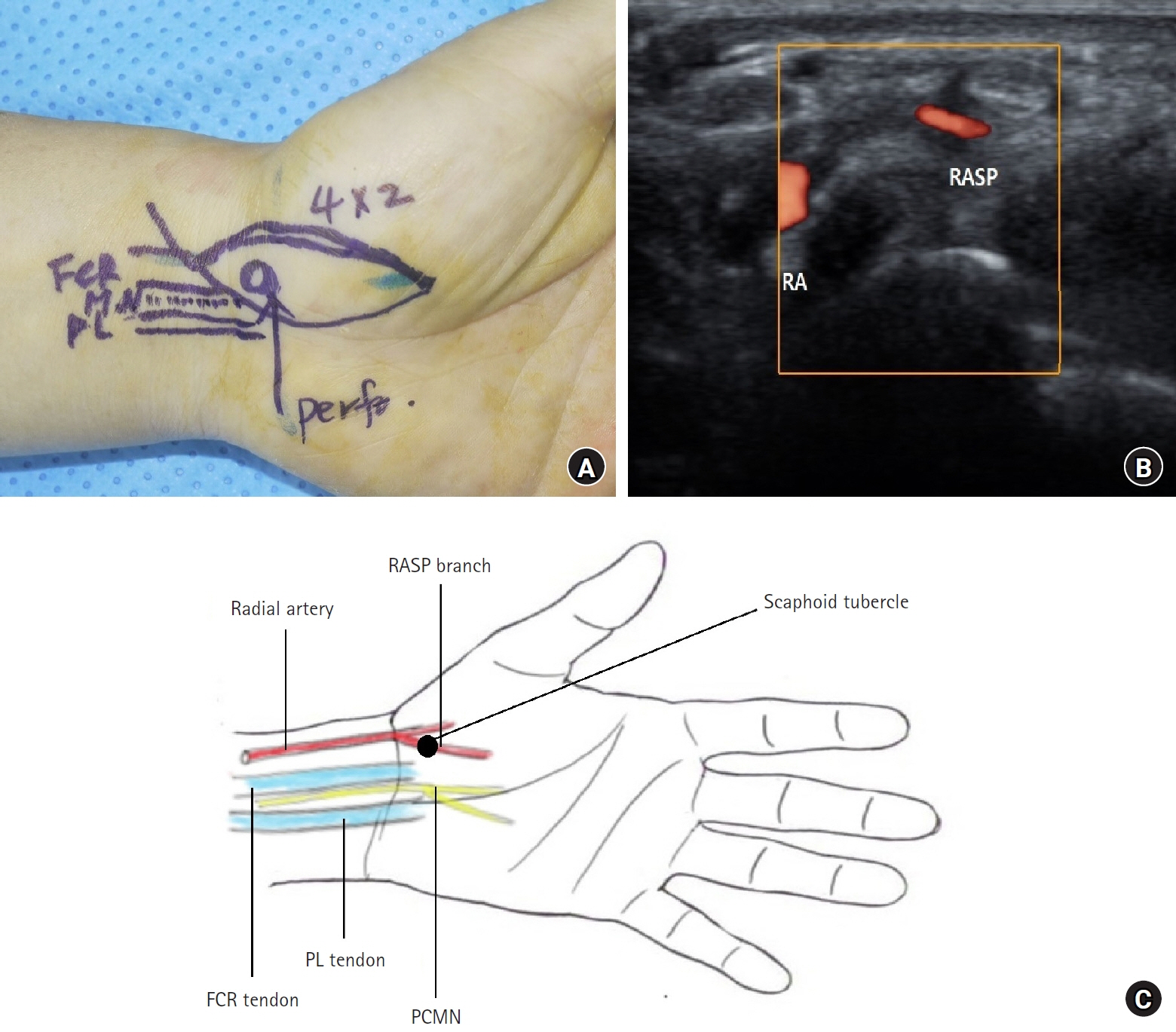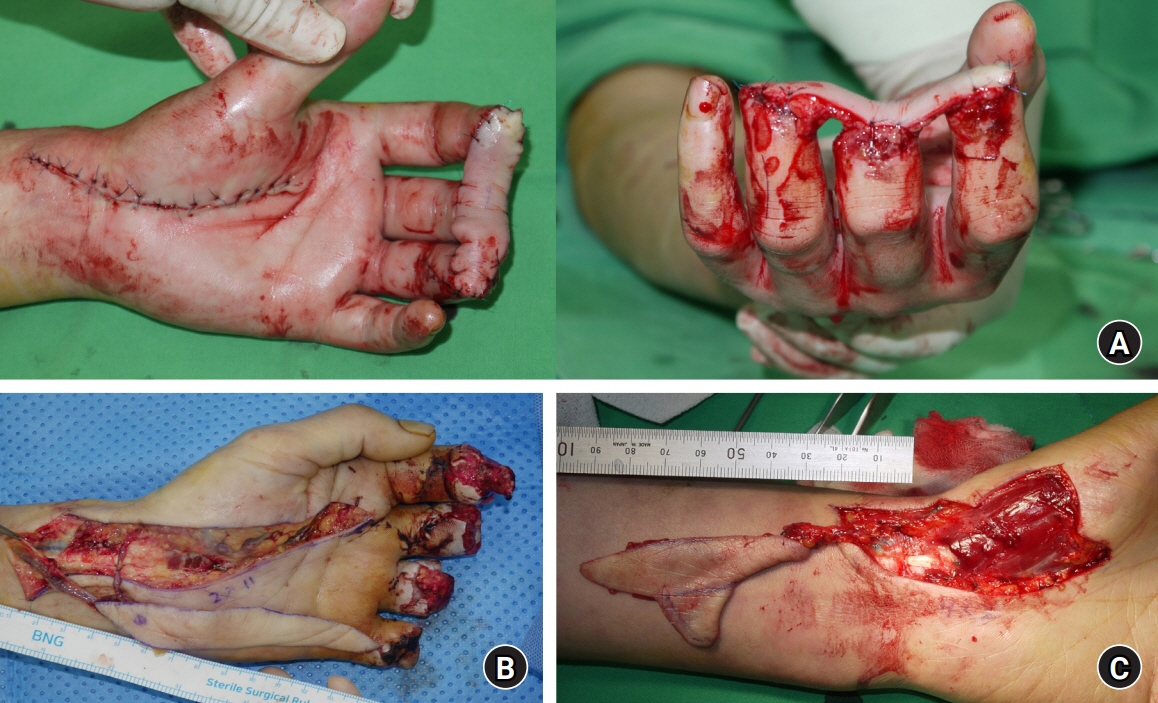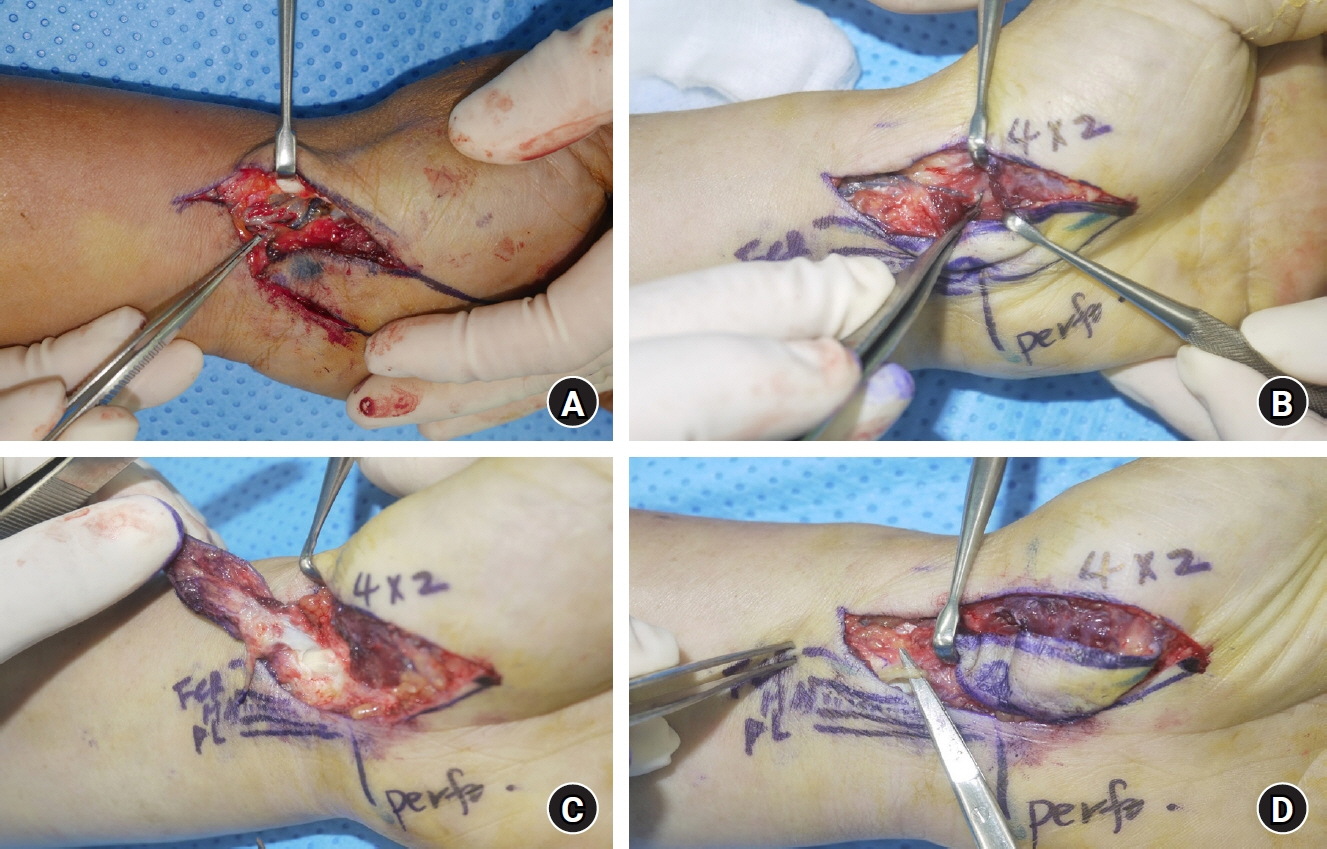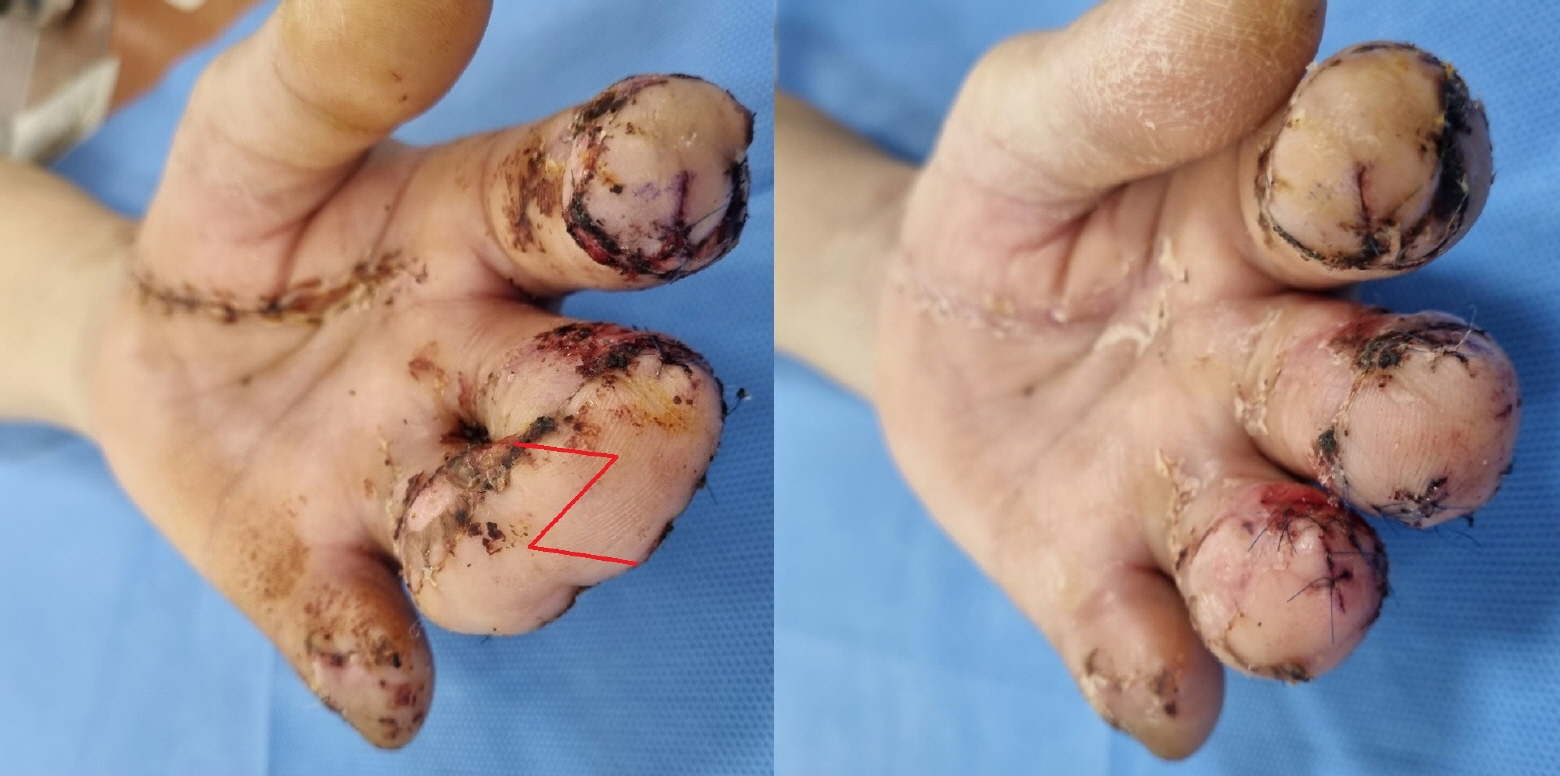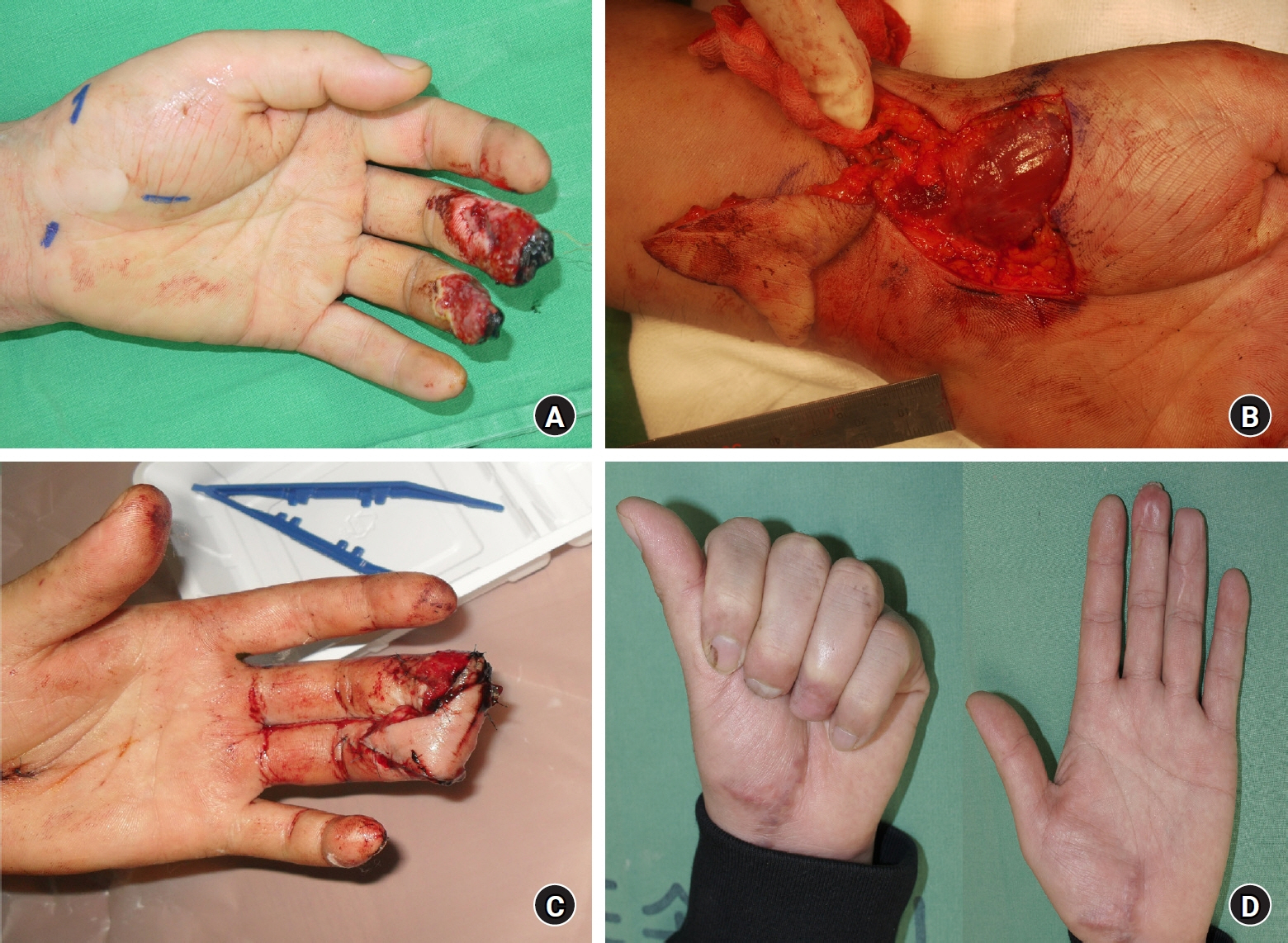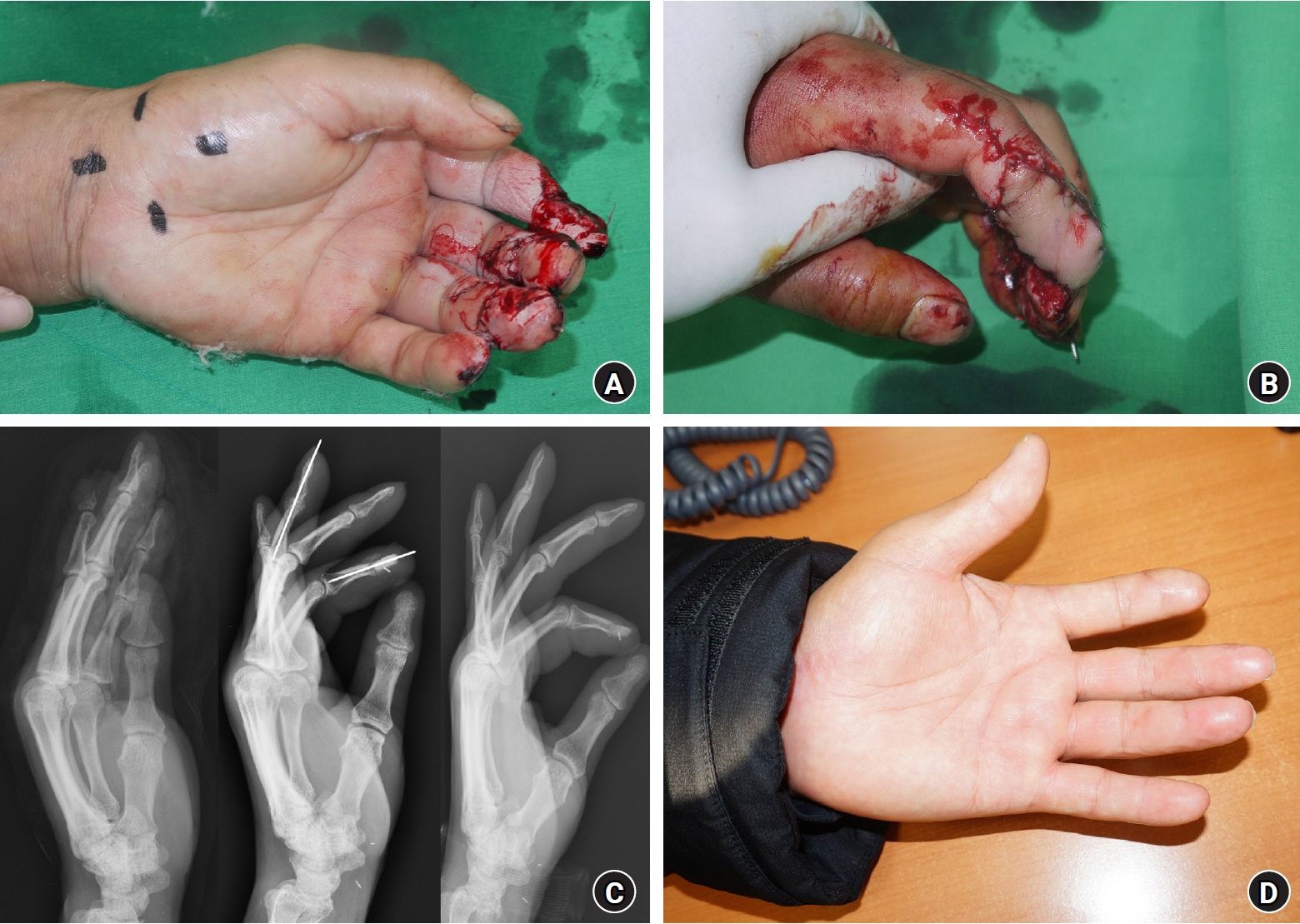Arch Hand Microsurg.
2023 Sep;28(3):174-187. 10.12790/ahm.23.0017.
Finger defect reconstruction using the radial artery superficial palmar branch free flap
- Affiliations
-
- 1Department of Plastic and Reconstructive Surgery, Institute of Hand and Microsurgery, Duson Hospital, Ansan, Korea
- 2Department of Orthopedic Surgery, Institute of Hand and Microsurgery, Duson Hospital, Ansan, Korea
- 3Department of Plastic and Reconstructive Surgery, Wellson Hospital, Siheung, Korea
- 4Department of Orthopedic Surgery, Wellson Hospital, Siheung, Korea
- 5Department of Orthopedic Surgery, Hyungje Orthopedics and Neurosurgery, Ansan, Korea
- KMID: 2545528
- DOI: http://doi.org/10.12790/ahm.23.0017
Abstract
- Purpose
The radial artery superficial palmar branch (RASP) free flap is accepted as a surgical technique for the reconstruction of finger defects. This study revisited the RASP free flap and evaluated its reliability and usefulness in a variety of finger defects.
Methods
From January 2017 to December 2022, multiple surgeons at a single institution performed a total of 315 RASP free flap reconstructions. Basic patient demographics and information on the finger defect and flap were assessed, and immediate postoperative flap and donor site-related complications were also studied. Data regarding long-term outcomes, such as the thumb joint range of motion and static two-point discrimination (S2PD), were collected and evaluated to identify statistically significant differences from the unaffected or non-innervated side.
Results
The mean postoperative follow-up was 14.8 months. The total flap survival rate was approximately 91.4%. There was no statistically significant difference in mean postoperative palmar abduction and radial abduction between the affected and unaffected thumbs in both groups. In the single-digit group, there was a statistically significant difference in S2PD between the innervated flap and unaffected side. A statistically significant difference was also found between innervated and non-innervated flaps in the multiple-digits group.
Conclusion
The RASP free flap is a valuable surgical option in reconstructing finger defects. It has already been proven to be safe and useful in coverage of single and tip defects. Stability should be ensured when there are multiple defects. Finally, the donor site morbidity is minimal and the recovery of sensation, once the flap is reinnervated, could be promising.
Figure
Reference
-
References
1. Al-Qattan MM. The adipofascial turnover flap for coverage of the exposed distal interphalangeal joint of the fingers and interphalangeal joint of the thumb. J Hand Surg Am. 2001; 26:1116–9.
Article2. Yang JW, Kim JS, Lee DC, et al. The radial artery superficial palmar branch flap: a modified free thenar flap with constant innervation. J Reconstr Microsurg. 2010; 26:529–38.
Article3. Atasoy E. Reversed cross-finger subcutaneous flap. J Hand Surg Am. 1982; 7:481–3.
Article4. Tare M, Ramakrishnan V. Free ‘mini’ groin flap for digital resurfacing. J Hand Surg Eur Vol. 2009; 34:336–42.
Article5. van den Berg WB, Vergeer RA, van der Sluis CK, Ten Duis HJ, Werker PM. Comparison of three types of treatment modalities on the outcome of fingertip injuries. J Trauma Acute Care Surg. 2012; 72:1681–7.
Article6. Grad JB, Beasley RW. Fingertip reconstruction. Hand Clin. 1985; 1:667–76.
Article7. Allen MJ. Conservative management of finger tip injuries in adults. Hand. 1980; 12:257–65.
Article8. Krauss EM, Lalonde DH. Secondary healing of fingertip amputations: a review. Hand (N Y). 2014; 9:282–8.
Article9. Peterson SL, Peterson EL, Wheatley MJ. Management of fingertip amputations. J Hand Surg Am. 2014; 39:2093–101.
Article10. Lanzetta M, Mastropasqua B, Chollet A, Brisebois N. Versatility of the homodigital triangular neurovascular island flap in fingertip reconstruction. J Hand Surg Br. 1995; 20:824–9.
Article11. Sakai S. Free flap from the flexor aspect of the wrist for resurfacing defects of the hand and fingers. Plast Reconstr Surg. 2003; 111:1412–22.
Article12. Abbase EH, Tadjalli HE, Shenaq SM. Fingertip and nail bed injuries: repair techniques for optimum outcome. Postgrad Med. 1995;98:217-9, 223-4, 230 passim.13. Benito JR, Ferreres A, Rodriguez-Baeza A, Monner J, Paloma V, Serra JM. Is the reversed fourth dorsal metacarpal flap reliable? J Hand Surg Br. 2000; 25:135–9.
Article14. Wray RC, Wise DM, Young VL, Weeks PM. The groin flap in severe hand injuries. Ann Plast Surg. 1982; 9:459–62.
Article15. Melone CP Jr, Beasley RW, Carstens JH Jr. The thenar flap: an analysis of its use in 150 cases. J Hand Surg Am. 1982; 7:291–7.16. Cohen BE, Cronin ED. An innervated cross-finger flap for fingertip reconstruction. Plast Reconstr Surg. 1983; 72:688–97.
Article17. Nakazawa H, Nozaki M, Kikuchi Y, Honda T, Isago T, Sasaki K. Successful reconstruction of the ring finger using a twisted toe flap. J Reconstr Microsurg. 2004; 20:615–20.
Article18. Omokawa S, Mizumoto S, Iwai M, Tamai S, Fukui A. Innervated radial thenar flap for sensory reconstruction of fingers. J Hand Surg Am. 1996; 21:373–80.19. Kamei K, Ide Y, Kimura T. A new free thenar flap. Plast Reconstr Surg. 1993; 92:1380–4.20. Kim KS, Kim ES, Hwang JH, Lee SY. Fingertip reconstruction using the hypothenar perforator free flap. J Plast Reconstr Aesthet Surg. 2013; 66:1263–70.
Article21. Koshima I, Urushibara K, Fukuda N, et al. Digital artery perforator flaps for fingertip reconstructions. Plast Reconstr Surg. 2006; 118:1579–84.
Article22. Lee DC, Kim JS, Ki SH, Roh SY, Yang JW, Chung KC. Partial second toe pulp free flap for fingertip reconstruction. Plast Reconstr Surg. 2008; 121:899–907.23. Pan ZH, Jiang PP, Wang JL. Posterior interosseous free flap for finger re-surfacing. J Plast Reconstr Aesthet Surg. 2010; 63:832–7.
Article24. Lee HB, Tark KC, Rah DK, Shin KS. Pulp reconstruction of fingers with very small sensate medial plantar free flap. Plast Reconstr Surg. 1998; 101:999–1005.
Article25. Ki SH, Yoon JM, Park TJ, Choi MS, Hong MK. Reconstruction of multiple digital defects by temporary syndactylization using a lateral arm free flap. Arch Plast Surg. 2022; 49:745–9.
Article26. Omokawa S, Ryu J, Tang JB, Han J. Vascular and neural anatomy of the thenar area of the hand: its surgical applications. Plast Reconstr Surg. 1997; 99:116–21.
Article27. Olave E, Prates JC, Gabrielli C, Del Sol M, Mandiola E. Abnormal course of the superficial palmar branch of the radial artery. Surg Radiol Anat. 1996; 18:151–3.
Article28. Tagil SM, Bozkurt MC, Kuvat SV, Cicekcibasi AE. A variant course of the superficial palmar branch of the radial artery. Surg Radiol Anat. 2012; 34:871–3.
Article29. Yang JW. Anatomical variations of the innervated radial artery superficial palmar branch flap: a series of 28 clinical cases. Arch Plast Surg. 2020; 47:435–43.
Article30. Lee SH, Cheon SJ, Kim YJ. Clinical application of a free radial artery superficial palmar branch flap for soft-tissue reconstruction of digital injuries. J Hand Surg Eur Vol. 2017; 42:151–6.31. Aksoy A, Sir E, Dagdelen D, Aksoy MK. Reconstruction of finger composite defects with perforator free flap from the superficial palmar branch of radial artery. Turk J Plast Surg. 2018; 26:44–9.
Article32. Kim YJ, Suh YS, Lee SH, Hahm DG. The radial artery superficial palmar (RASP) branch free flap for finger soft tissue reconstruction. J Korean Soc Microsurg. 2012; 21:21–6.33. Lee J, Park HS, Oh BS, Whang JI, Seo HG. Reconstruction of multiple fingertip defects using the innervated radial artery superficial palmar branch perforator flap. Arch Hand Microsurg. 2019; 24:368–75.
Article34. Iwuagwu FC, Orkar SK, Siddiqui A. Reconstruction of volar skin and soft tissue defects of the digits including the pulp: experience with the free SUPBRA flap. J Plast Reconstr Aesthet Surg. 2015; 68:26–34.
Article35. Han SK, Lee BI, Kim WK. The reverse digital artery island flap: clinical experience in 120 fingers. Plast Reconstr Surg. 1998; 101:1006–13.
Article36. Han SK, Lee BI, Kim WK. The reverse digital artery island flap: an update. Plast Reconstr Surg. 2004; 113:1753–5.
Article37. Usami S, Kawahara S, Yamaguchi Y, Hirase T. Homodigital artery flap reconstruction for fingertip amputation: a comparative study of the oblique triangular neurovascular advancement flap and the reverse digital artery island flap. J Hand Surg Eur Vol. 2015; 40:291–7.
Article
- Full Text Links
- Actions
-
Cited
- CITED
-
- Close
- Share
- Similar articles
-
- The Radial Artery Superficial Palmar (RASP) Branch Free Flap for Finger Soft Tissue Reconstruction
- Proximal bifurcation of the superficial palmar branch of the radial artery and anomalous superficial course of the distal radial artery: a case report
- Anatomical variations of the innervated radial artery superficial palmar branch flap: A series of 28 clinical cases
- Reconstruction of the Fingertip Defect with a Free Radial Artery Superficial Palmar Branch Flap and Iliac Bone Graft
- Reconstruction of Soft Tissue Defect of the Finger with Thenar Free Flap

